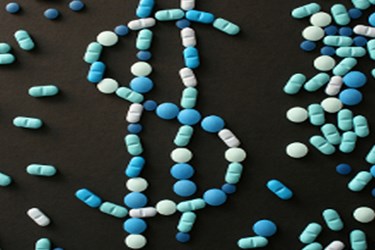Relative Cost Models: A Better Way To Look At Risk/Reward During Early Drug Development?

By Jeffrey P. Kiplinger, Ph.D., founder and president, Averica Discovery Services
Trying to add value while maintaining cost-effectiveness in drug development is like a game of chicken. When faced with two highly important but opposing directives, we often wait to see who blinks first.
Let’s consider a “hard choice” often faced in early development. A common belief in developing chiral compounds is that one should eliminate chromatography from API production processes as early as possible. The rationale is that chromatography is always going to be expensive as you get to larger scale. Even a low-yield process that introduces asymmetry through synthesis, or a classical resolution, is going to be much cheaper. The challenge is that no one tells you what early means. So the team is left to choose when to kick off the effort to, for example, develop an enantiospecific synthesis. Who will blink first: the cautious development team or the hard-driving discovery team?
True, chromatography is expensive, but proven and moderately scalable. The downside of synthetic processes is that, while they’re highly scalable and relatively inexpensive at large scale, they take longer to develop, which needs to be accounted for in the timeline. A careful team will try to understand the relative cost in terms of time, resources, potential for delays, risks to quality, etc.
It’s easy to look at absolute costing – get the price quotes and timelines. But a dollar-cost-model tends to provide a false sense of precision; it implies an accuracy that isn’t there at all. It’s called the “false precision fallacy” or “spurious accuracy.” This is similar to a museum guide saying the tyrannosaur skeleton is 65,000,005 years old; he was told it was sixty-five million years old when he started working as a guide five years before.
By focusing on dollars, we also often fail to factor in risks. A more effective approach may be to use a relative cost model that considers a range of variables that can be weighted based on their degree of importance. Think of things like time to delivery, quality, costs, control, and confidence in your supply forecasting.
We recommend starting with an estimate of the dollar cost (factoring in timelines!), and simply adjusting each option for the weighted “soft factors”. With a relative model of risk, teams can better identify and anticipate supply and quality risks, resource risks, and the risks of oversupplying a program relative to its long term viability – all of which are vitally important variables that get overlooked when focusing solely on cost.
If we just do a cost analysis of a synthesis vs. a separation, we’re neglecting some important facts. If the single isomer is of interest in early development, there’s probably already a chiral chromatographic process to deliver it. So chromatography is low risk, and has a known cost and timeline. Moreover, the program itself has an inherent risk: the compound may not prove suitable for further development. If this happens, and we know that’s part of the normal course of R&D, the development effort spent on an asymmetric synthesis will be money down the drain.
If the cost of chromatography is deemed too high when the deliverable is, say, a kilo of material, teams can look at ways to influence the relative costs by improving the equation for the chromatographers. Two key benefits of chromatography are convenience and rapid scalability. In other words, you can ensure a supply on short notice until your program needs a big ongoing production schedule. From a risk management perspective, it makes sense to use chromatography for as long as you practically can.
Chemistry-driven project teams tend to think of chromatography as a black box resource – send the compound to the experts, and trust it will come back clean and on time. To get a kilo of material in a cost-effective manner, a closer collaboration between the chemist and the chromatographer is important. We’ve found a number of “points of attack” at the chemistry-chromatography interface that can be used to re-balance the relative cost model in favor of chromatography:
- Resolve an intermediate. Many times the last steps in a synthesis have no effect on a chiral center. If the products at these steps are isolated, they offer alternative feedstocks for chromatographic resolution that might make the process faster and cheaper.
- Derivatize or add a protecting group. Often chromatography is slow or inefficient due to polar functional groups like acids or amines that interact with the column substrate. These groups are often easily “protected,” making less polar derivatives that chromatograph well and can be easily converted back to the free functional group after chiral separation.
- Work from an enriched feedstock. Already working to develop an asymmetric synthesis, but not getting high enough enantiopurity? You may have just made a better feedstock for chromatography by enriching the needed enantiomer!
- Always know which enantiomer you want. In a chiral separation, the earlier eluting enantiomer is often captured at high yield and enantiopurity more easily than the later peak. Chromatographers can often control the order of elution of enantiomers. If you have a small standard sample of the desired isomer, it might be easy to develop a more efficient separation in which the needed compound elutes first.
We use relative costing in many applications, but this one is a great example of how a simple scratchpad calculation can drive a team toward a sound and long-term strategy decision. That strategy can be further developed when the choices aren’t seen as isolated options – “this is what it will cost, and that’s how long it will take” – but as part of a larger multidisciplinary effort to make the best decisions on compound development.
Over the last 25 years, companies have taken advantage of externalization of development and clinical from discovery to profiling to the clinic to manufacturing. Pharmaceutical R&D is a highly-specialized, complex field in which innovation and smart thinking trumps turn-the-handle process. Whether your multidisciplinary team is in-house or draws from CROs’ and CMOs’ experience, making sure all members bring something to the table helps ensure a successful and speedy development path.

About The Author
Jeffrey P. Kiplinger, Ph.D., founder and president of Averica Discovery Services in Marlborough MA, works to speed the discovery of small molecule therapeutics through IND-enabling analytical development services.
